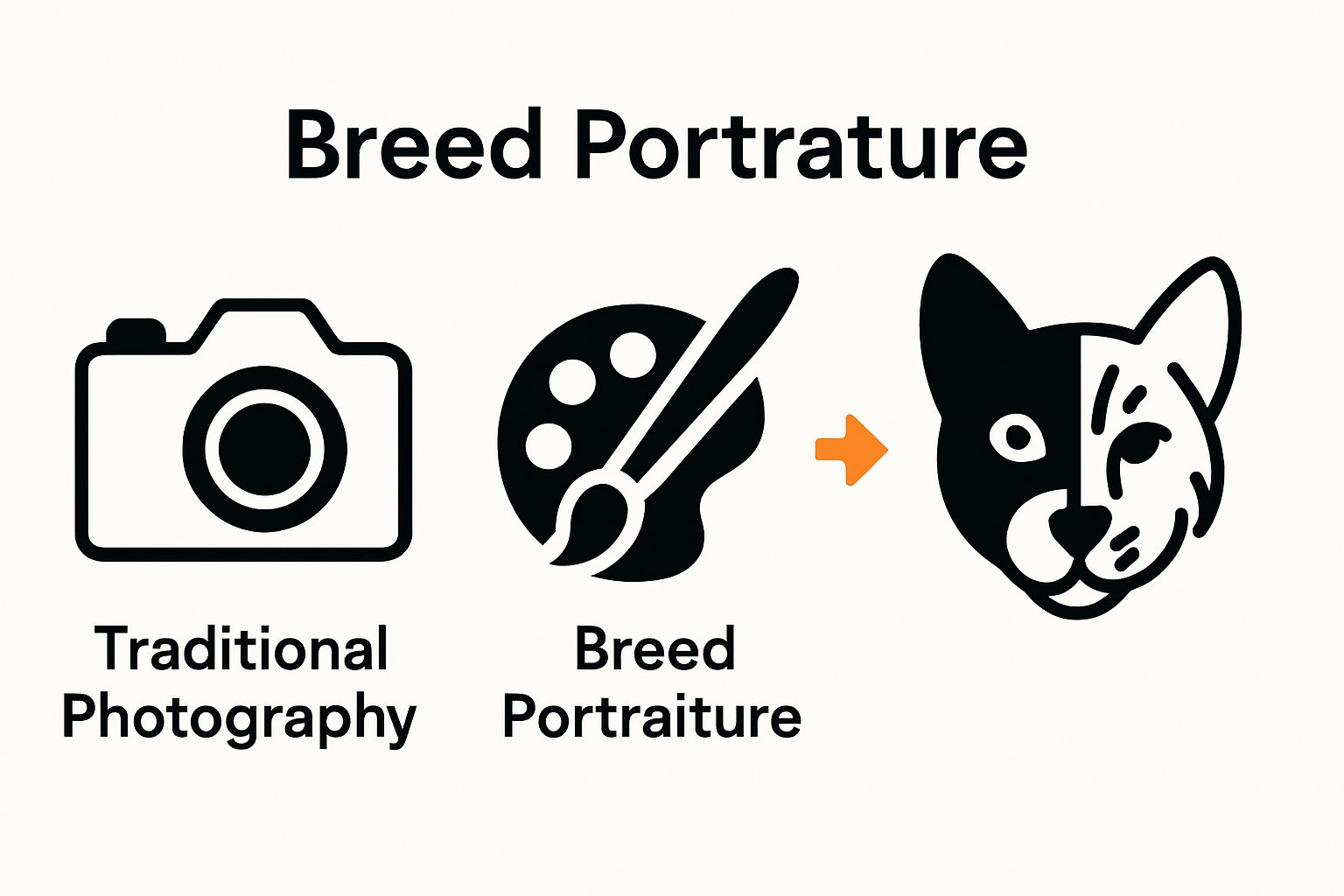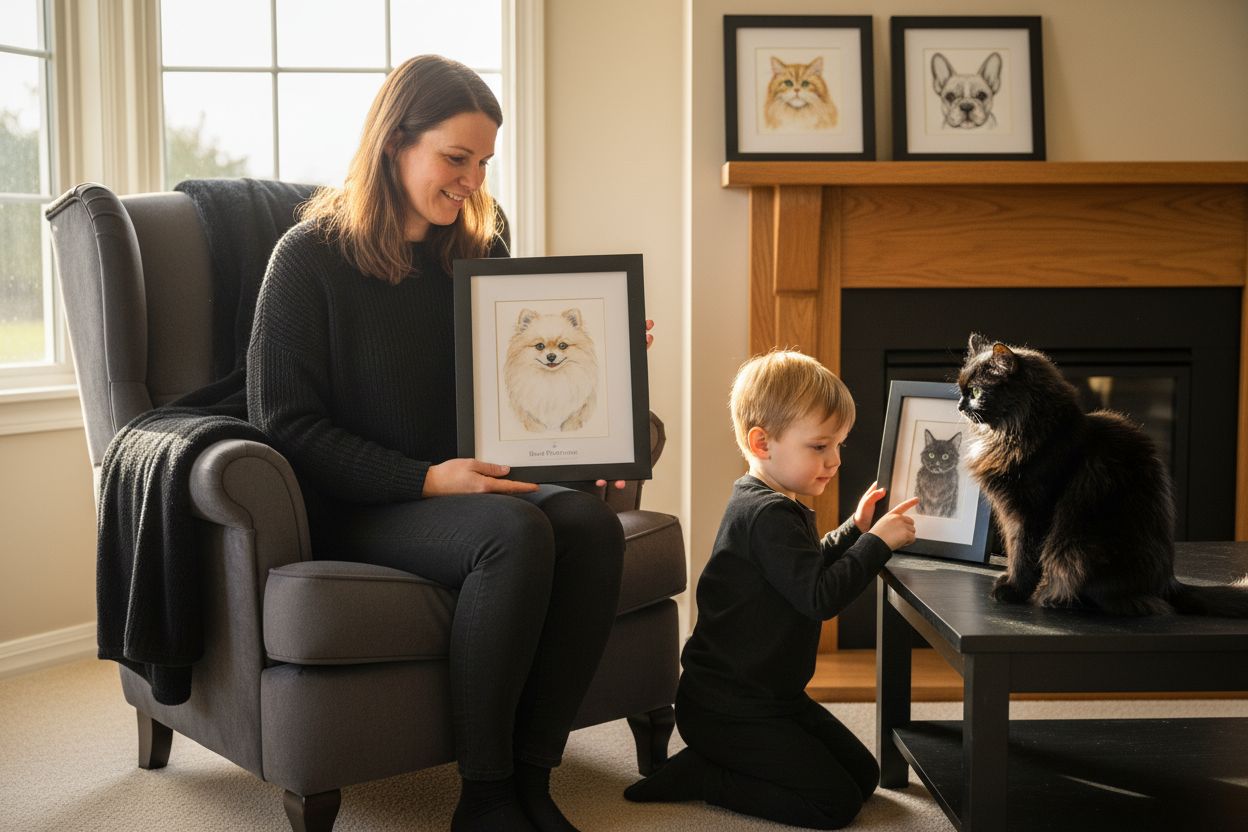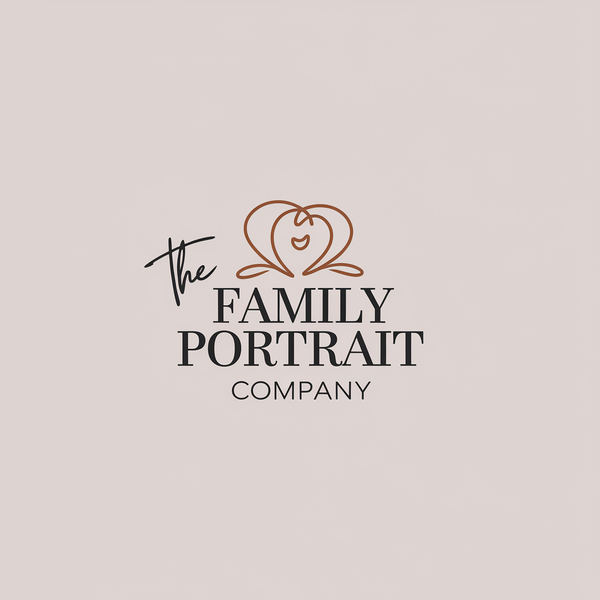
What is Pet Breed Portraiture? Understanding Pet Art
Partager
Pet breed portraiture seems like a simple exercise in capturing your favourite animal’s face, complete with wagging tails or perky ears. But look closer. Detailed portraits can preserve nuanced breed characteristics and serve as vital scientific records for genetic research. While most people hang them above the mantel for warm memories, these artworks quietly tell a story about evolution, identity, and the unique spirit living behind those painted eyes.
Table of Contents
- Defining Pet Breed Portraiture: A Unique Art Form
- The Importance of Pet Breed Portraiture in Animal Representation
- How Pet Breed Portraiture Captures Personality and Emotion
- The Techniques and Styles in Pet Breed Portraiture
- Real-World Applications and Cultural Significance of Pet Portraits
Quick Summary
| Takeaway | Explanation |
|---|---|
| Pet breed portraiture preserves unique traits. | This art form documents vital breed characteristics, helping to maintain genetic diversity over time. |
| Emotional depth is crucial for portraits. | Artists convey personality and emotion through detailed expressions, enhancing the connection between animals and viewers. |
| Portraits support scientific research. | They serve as visual records for veterinarians and geneticists, aiding in understanding breed evolution. |
| Art styles impact representation accuracy. | Techniques like oil painting or digital illustration influence how accurately breeds are depicted. |
| Pet portraits serve as emotional memorials. | They immortalise beloved animals, creating lasting memories that encapsulate shared experiences and bonds. |
Defining Pet Breed Portraiture: A Unique Art Form
Pet breed portraiture represents a specialised artistic practice that transforms animal representation beyond traditional photography. Portraiture research reveals this art form as a nuanced approach to capturing the distinct physical characteristics, personality, and essence of specific animal breeds.
The Essence of Breed-Specific Representation
Breed portraiture goes far beyond standard pet photography. It requires deep understanding of breed-specific traits, physical conformations, and characteristic expressions. Artists specialising in this genre meticulously study breed standards, examining subtle details that distinguish one breed from another. Whether depicting a muscular Boxer with its distinctive square muzzle or a delicate Cavalier King Charles Spaniel with its soft, expressive eyes, these portraits celebrate the unique genetic heritage of each animal.

Artistic Techniques and Approaches
Artists employ various techniques to create compelling breed portraits. Some utilise traditional mediums like oil painting, watercolour, or pencil sketching, while others explore digital illustration and mixed media. The goal remains consistent: capturing not just the physical likeness, but the spirit and characteristic movements unique to each breed.
For those interested in exploring different pet portrait styles, understanding these nuanced artistic approaches becomes crucial. Each portrait tells a story, revealing the breed’s historical background, temperament, and individual personality through carefully selected visual elements.
Breed portraiture serves multiple purposes beyond aesthetic appreciation. It documents breed characteristics, preserves genetic diversity awareness, and creates lasting memories that honour the unique qualities of beloved animal companions.
The Importance of Pet Breed Portraiture in Animal Representation
Pet breed portraiture transcends mere artistic expression, serving critical roles in documentation, preservation, and cultural understanding. Comparative Animal Studies highlights the significant anthropological and scientific value inherent in detailed breed representations.
Documenting Genetic Diversity and Breed Characteristics
Breed portraiture functions as a vital historical and scientific documentation tool. By meticulously capturing breed-specific traits, these artworks create visual archives that record physical characteristics, helping veterinarians, geneticists, and breed enthusiasts track subtle evolutionary changes. Detailed portraits preserve nuanced physical attributes that might otherwise be lost to time, providing researchers with valuable reference materials for understanding breed development and genetic variations.
Cultural and Emotional Significance
Beyond scientific documentation, pet breed portraiture carries profound emotional and cultural significance. These artworks celebrate the unique relationship between humans and animals, transforming individual pet representations into powerful narratives of companionship. Explore inspiring examples of how pet portraits capture emotional connections, revealing the deep bonds that exist between different animal breeds and their human families.
Key aspects of pet breed portraiture’s importance include:
- Preserving breed-specific genetic information
- Creating emotional memorials for beloved animal companions
- Documenting subtle physical variations within breed standards
- Celebrating the unique characteristics of different animal lineages
Ultimately, pet breed portraiture represents a sophisticated intersection of art, science, and emotional expression. By capturing the essence of specific breeds, these artistic representations contribute to our broader understanding of animal diversity, heritage, and the intricate relationships between humans and their animal companions.
How Pet Breed Portraiture Captures Personality and Emotion
Expressionist art theory reveals that capturing emotional essence goes beyond physical representation. Pet breed portraiture transforms visual documentation into profound emotional narratives that communicate the intricate inner worlds of animal companions.
Emotional Landscape of Animal Expression
Portrait artists employ sophisticated techniques to translate an animal’s unique personality into visual language. Emotional depth emerges through nuanced details such as the angle of ears, the intensity of eye contact, and subtle muscular tensions that reveal individual character. A Border Collie’s portrait might showcase intense focus and intelligence, while a Labrador Retriever’s artwork captures boundless enthusiasm and warmth.
Psychological Dimensions of Breed Representation
Beyond physical likeness, these portraits explore psychological territories unique to specific breeds. Artists decode breed-specific temperaments, translating inherited traits into visual metaphors. Discover creative approaches to capturing your pet’s unique spirit, where each brushstroke or digital rendering becomes a window into the animal’s inner emotional landscape.
Key emotional elements artists consider include:
- Subtle eye expressions revealing individual personality
- Body language communicating breed-specific traits
- Contextual environments reflecting animal’s natural instincts
- Colour palettes evoking emotional temperatures
Ultimately, pet breed portraiture transcends mere documentation, becoming a profound dialogue between artist, animal, and viewer. These portraits invite audiences to recognise the rich emotional complexity residing within different animal breeds, celebrating their unique spirits and deepening our understanding of interspecies connections.
The Techniques and Styles in Pet Breed Portraiture
Realism art movement provides foundational principles for understanding the intricate techniques and styles used in pet breed portraiture. Artists employ diverse methodologies to capture the essence of different animal breeds with extraordinary precision and emotional depth.
Traditional Artistic Mediums
Classical techniques remain fundamental in breed portraiture. Oil painting allows for rich, layered representations that capture minute breed-specific details. Watercolour techniques offer delicate, nuanced interpretations of fur textures and subtle breed characteristics. Pencil and charcoal drawings provide extraordinary opportunities for exploring intricate muscular structures and breed-specific facial expressions. Precision becomes the hallmark of exceptional breed portraiture, with artists spending considerable time understanding anatomical subtleties.
Contemporary Digital and Mixed Media Approaches
Modern technology has revolutionised pet breed portraiture, introducing digital illustration and mixed media techniques that expand artistic possibilities. Discover innovative pet portrait styles that blend traditional and contemporary approaches, where digital tools complement traditional artistic skills. Graphic designers and digital artists now create hyperrealistic representations that capture breed characteristics with unprecedented accuracy.
Key artistic techniques in breed portraiture include:
- Photorealistic rendering of breed-specific physical traits
- Emotional interpretation through colour and compositional choices
- Detailed anatomical studies emphasising breed characteristics
- Experimental approaches blending multiple artistic styles
Breed portraiture represents a sophisticated dialogue between artistic technique, scientific observation, and emotional expression. By employing diverse stylistic approaches, artists create powerful visual narratives that celebrate the unique identity of different animal breeds.
The following table compares key artistic mediums and approaches discussed in pet breed portraiture, summarising their main features and contributions to the art form.
| Artistic Approach | Medium/Tool | Key Features | Contribution to Portraiture |
|---|---|---|---|
| Traditional Oil Painting | Oil paints, canvas | Rich layering, fine detail, depth of colour | Captures subtle breed distinctions |
| Watercolour | Watercolour, paper | Delicate washes, soft textures, gentle blending | Highlights nuanced fur and features |
| Pencil/Charcoal Drawing | Graphite, charcoal, paper | High precision, focus on anatomy, fine lines | Explores musculature and expressions |
| Digital Illustration | Graphics tablet, software | Hyperrealism, versatility, editable layers | Achieves photographic detail, flexibility |
| Mixed Media | Combination | Creative textures, experimental styles | Blends tradition with innovation |
Real-World Applications and Cultural Significance of Pet Portraits
Animal Studies Research demonstrates that pet portraits extend far beyond aesthetic appreciation, serving critical roles in social documentation, emotional preservation, and cultural memory. These artistic representations capture profound narratives about human animal relationships.
Commemorative and Emotional Preservation
Pet portraits function as powerful emotional archives, transforming fleeting moments into lasting memories. Families commission these artworks to immortalise beloved companions, creating tangible connections that transcend an animal’s natural lifespan. A meticulously crafted portrait becomes more than an image it represents a cherished relationship, capturing personality, spirit, and shared experiences that define deep interspecies bonds.
Professional and Scientific Documentation
Beyond personal memorialisation, pet breed portraiture serves professional and scientific communities. Veterinary researchers, breed associations, and genetic historians utilise these detailed representations to document physical characteristics, track breed evolution, and preserve visual genetic records. Learn about the advantages of professional pet portrait preservation, which contribute to broader understanding of animal genetics and breed development.
Significant applications of pet portraiture include:
- Documenting breed characteristics for genetic research
- Creating emotional memorials for family histories
- Supporting veterinary and zoological documentation
- Exploring cultural relationships with companion animals
Pet portraits represent a sophisticated intersection of art, emotion, and scientific documentation.
This table outlines the primary purposes and applications of pet breed portraiture, clarifying how they serve both personal and professional communities.
| Application Area | Purpose | Who Benefits | Example Use Case |
|---|---|---|---|
| Emotional Memorial | Preserve memories, honour bond | Pet owners, families | Hanging portraits at home as keepsakes |
| Genetic and Scientific Documentation | Record physical traits, track evolution | Veterinarians, researchers | Analysing portraits for breed studies |
| Cultural Representation | Celebrate human-animal relationships | Society, historians | Featuring portraits in exhibitions |
| Professional Reference | Support breed identification and education | Breed associations, artists | Standardising breed visuals in manuals |

Celebrate Your Pet’s Unique Breed with a Custom Portrait
You have just discovered how pet breed portraiture captures more than appearance. It reveals personality, breed standards, and the cherished bond between you and your animal companion. Perhaps you wish you could honour your pet’s individual character beyond a snapshot. Maybe you are searching for a special way to preserve distinctive breed traits and create a beautiful emotional memorial. These are challenges many passionate pet owners face, especially when words cannot express how much your pet means to you.
Explore our Custom Pet Portrait Collection and let professional artists transform your favourite photo into artwork that highlights everything remarkable about your pet’s breed.

Do not let those memories fade. Visit The Family Portrait Company today and commission a portrait that truly captures your pet’s unique spirit and heritage. Order now for a timeless keepsake you will treasure for years to come.
Frequently Asked Questions
What is pet breed portraiture?
Pet breed portraiture is a specialised art form that captures the distinct physical characteristics and personality of specific animal breeds. To understand this unique art, engage with artists who specialise in pet portraiture and explore their techniques.
How does pet breed portraiture differ from standard pet photography?
Unlike standard pet photography, pet breed portraiture focuses on breed-specific traits and expressions, requiring a deep understanding of each breed’s characteristics. To appreciate the nuances, study different breed standards and observe how they influence portrait art.
What artistic techniques are commonly used in pet breed portraiture?
Artists use various techniques, including traditional mediums like oil painting and watercolour, as well as digital illustration. To see the diversity of approaches, visit galleries or online platforms showcasing pet breed portraits.
How can pet breed portraits document genetic diversity?
Pet breed portraits serve as visual archives that record the physical characteristics of breeds, which can be crucial for tracking evolutionary changes. To contribute to preserving this diversity, consider commissioning or creating detailed breed portraits that capture specific traits.
What emotional significance do pet breed portraits hold?
Pet breed portraits celebrate the bond between humans and animals, turning individual representations into powerful narratives of companionship. To create a lasting memory, think about commissioning a portrait that reflects your pet’s unique personality and spirit.
Recommended
- Understanding Pet Portrait Styles Explained for Pet Owners – The Family Portrait Companys
- 7 Inspiring Examples of Pet Portraits to Cherish – The Family Portrait Companys
- Understanding the Advantages of Pet Portraits – The Family Portrait Companys
- Understanding Why Commission Pet Portraits Matter – The Family Portrait Companys
